
* The de Havilland Vampire was Britain's second jet fighter to reach full operational service. It proved very satisfactory, was built in large numbers, and served with many different air arms around the world.
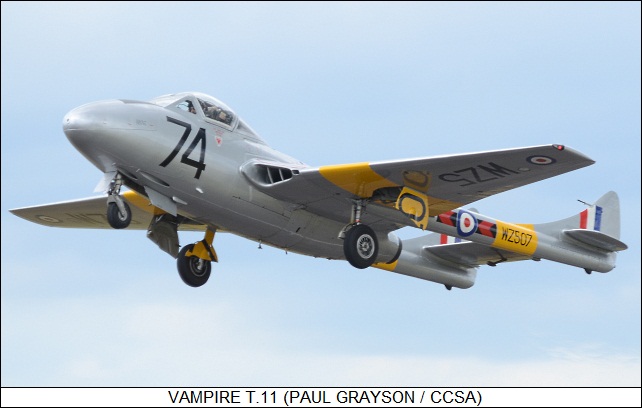
* During the 1930s, a British Royal Air Force (RAF) officer named Frank Whittle performed research on turbojet propulsion, leading to the first flight of a British jet aircraft, the "Gloster G.40" or "Gloster Whittle", on 15 May 1940. The G.40's powerplant was built by Whittle's company Power Jets and was of "centrifugal flow" configuration, meaning that its compressor was based on an impeller like that of a pump, not a series of fans as used in more modern "axial flow" turbojets. Centrifugal flow engines would eventually prove to be a dead end as far as high-speed jet aircraft were concerned, though turboprop and turboshaft engines still often use the configuration. However, at the outset of the jet age, the centrifugal flow turbojet was perfectly effective, and much easier to get into service than the axial flow engine.
Due to the pressures of war, further development of Whittle's engine concepts went slowly for a few years, but by early 1943 work was getting on track, with both the Rolls-Royce and de Havilland companies working on improved, more powerful centrifugal flow engines based on Whittle's concepts. Gloster was working on a twin-engine jet fighter using such engines, named the "Meteor", which performed its first flight on 5 March 1943.
The British Air Ministry was also interested in a simple, lightweight, single-engine jet fighter with an armament of four 20-millimeter cannon, as defined in "Specification E.6/41". A design team at de Havilland, under company chairman Sir Geoffrey de Havilland and featuring Chief Designer R.E. Bishop, came up with the twin-boom "DH.100" design concept based on the Halford H.1 centrifugal flow engine, a Whittle derivative then being developed by Frank Halford of de Havilland. Air Ministry officials liked the idea and placed an order for two prototypes in April 1942, soon increasing the number to three.
Work went slowly for a time, since both de Havilland and the Air Ministry were more focused on other projects, but in November 1942 the priority of work on the DH.100 was raised. The project was assigned the codename "Spider Crab". Initial flight of the first prototype was on 20 September 1943, with Geoffrey de Havilland JR, company chief test pilot and son of the founder, at the controls. This machine was powered by a Halford H.1 turbojet with 12.0 kN (1,225 kgp / 2,700 lbf) thrust and was unarmed. The flight was satisfactory, though there were issues, such as oversensitive ailerons and some yaw instability.
First flight of the second prototype, with a configuration generally similar to the first, was on 17 March 1944. The third prototype featured armament and a Halford H.1A engine, with the same thrust as the H.1 but more robust in design. The third aircraft actually performed its initial flight earlier than the second, on 21 January 1944. The test and evaluation program went smoothly, with one RAF test pilot concluding that he "had never flown a nicer aircraft" -- though the yaw instability problem proved a bit tricky to work out.
A production contract was placed for 120 examples of the "Vampire Fighter Mark I" or "Vampire F.1" in May 1944, the name "Vampire" having been selected the previous month. Apparently it was originally designated "F.I", the RAF still using Roman numerals at the time, with the "F.1" more or less assigned in hindsight; the "F.1" designation will be used here for convenience. Initial flight of a production F.1 was on 20 April 1945. The first prototype was lost on 23 July 1945, when it pancaked in after take-off after a fuel pump failure, with the pilot, Geoffrey Pike, walking away unharmed. After varied careers in trials, the other two prototypes ended up in museums in the UK.
BACK_TO_TOP* The Vampire was a neat, distinctive aircraft, featuring a central fuselage pod resembling a stretched egg, a twin-boom tail attached to mid-mounted wings, with short-legged hydraulically-operated tricycle landing gear. All the gear assemblies had single wheels, with the nose wheel retracting backwards and the main gear hinged in the wings to retract outward. The air intakes were in the wing roots, with fuselage plates forward of the intakes to prevent ingestion of stagnant "boundary layer" airflow; the engine was in the rear of the fuselage and exhausted between the tail booms. The twin boom configuration minimized the length of the intake ducting and the exhaust pipe, reducing friction losses.
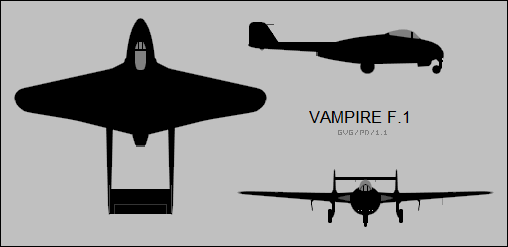
The wings were tapered, with an aileron outboard and a flap split by the tailboom inboard on each wing; there was an airbrake just outboard of the flap, in the form of a panel that popped up into the airflow. All flight controls were unpowered, actuated through cable connections. The tailfins were trapezoidal in form, with a straight tailplane between them; the tailplane did not extend outside of the tailfins in the F.1. There was a bumper under the rear of each boom.
Most of the fuselage was made of a sandwich of balsa planks between spruce plywood sheets, with the fuselage built in halves over molds using glues; the halves were then kitted up, fitted together, and covered with heavy cloth for painting. De Havilland had developed this technology, having put it to good use with the company's Mosquito and Hornet aircraft. The rest of the Vampire was made of metal, mostly aircraft aluminum alloy.
The pilot sat well forward, with an excellent forward field of view. Although the prototypes and early production F.1s featured a three-piece canopy, the 87th F.1 introduced a single-piece "teardrop" unit, which was much sturdier and provided a better all-round view. Most early production was refitted with the teardrop canopy. The windscreen was armor glass, with a glycol de-icer system, and the canopy slid backward to open. There was no ejection seat, and in fact the RAF would never fly a single-seat Vampire with such a nicety.
Armor plate was fitted to the back of the seat and an armor panel was fitted in front of the instrument panel. Avionics were simple, as they generally were at the time, consisting of an identification friend or foe (IFF) unit and a four-channel radio. It doesn't appear any radio navigation systems were fitted, but it is possible the radio had a radio compass capability. Cockpit pressurization was introduced in the 51st F.1, but it was not retrofitted to earlier aircraft.
Internal fuel capacity was 918 liters (242 US gallons), divided between a single fuselage tank with a capacity of 436 liters (115 US gallons) and a tank in each inner wing, providing a capacity of 241 liters (64 US gallons) each. All three tanks were made of metal and presumably were self-sealing. An external tank with a capacity of 227 liters (60 US gallons) or 455 liters (121 US gallons) could be carried under each wing. The aircraft was armed with four Hispano Mark V 20-millimeter cannon in the bottom of the nose, with a maximum of 150 rounds per gun. They were aimed by a reflector-type gunsight. There was a gun camera in the nose.
The F.1 was initially powered by the de Havilland Goblin 1 turbojet, which was the production model of the Halford H.IA and featured the same thrust, 12.0 kN (1,225 kgp / 2,700 lbf). The 41st F.1 introduced the Goblin 2, with 16.7 kN (1,705 kgp / 3,100 lbf) thrust. Incidentally, "Goblin" was also the name of a popular brand of vacuum cleaner, a coincidence that was not lost on jokers in the ranks of the RAF. Access to the engine was through removeable cowlings top and bottom, plus four service doors.
* The F.1 went into RAF service with 247 Squadron in March 1946, flying in the interceptor role. It then entered service with the 2nd Tactical Air Force in Germany, replacing Typhoons, Tempests, and Mustangs in the close-support role, and with the British Auxiliary Air Force. Production of the F.1 was farmed out to the English Electric company, which built 228, including four for evaluation by Switzerland and 70 (as "J 28As") for Sweden. Some of the F.1s would end up being used for trials of other variants.
The Vampire was known by RAF pilots as the "flying kiddie car", possibly because of its slightly toylike looks -- though this was apparently sometimes an unflattering reference by pilots of other aircraft. It appears that Vampire pilots themselves were very enthusiastic about their mount; it had no excess of power, giving it a sluggish climb rate and unspectacular performance at altitude, but it displayed a pleasing combination of agility and docile handling, being regarded as fun to fly. Apparently its worst problems were limited range, and the fact that it didn't give much stall warning.
BACK_TO_TOP* Although the vast majority of Vampires were powered by de Havilland Goblin engines, there was a branch of the family that was powered by the Rolls-Royce Nene centrifugal-flow turbojet, another descendant of Whittle's designs along a different path. The Nene was more powerful if heavier than the Goblin. Three of the Vampire F.1s were converted to "Vampire F.2" (originally "F.II") configuration by being fitted with a Nene RB.41 turbojet, providing 20.0 kN (2,040 kgp / 4,500 lbf) thrust. The Nene engine required additional airflow, which was provided by a pair of airscoops above the engine, known as "elephant ears".
The RAF placed an order for 60 F.2s, but as it turned out only two of that order were completed. Plans to obtain a "Vampire F.4" ground-attack variant with the Nene engine fell through, and no such variant was ever built. However, the Royal Australian Air Force (RAAF) found the variant interesting, and arranged for local license production of 80 Vampires with the Nene engine by Commonwealth Aircraft Corporation (CAC).
The first Australian-built Vampire performed its initial flight on 29 June 1949, with John "BlackJack" Walker at the controls. The first 57 of the batch were designated "F.30"; early production had the elephant ear intakes on top, as seen on the F.2 prototypes, but this configuration led to high-speed handling problems; the auxiliary intakes were relocated to the belly, with early production modified accordingly.
The last 23 of the batch, built in 1952 and 1953, featured clipped and stronger wings; they were given the designation of "Fighter Bomber Mark 31 (FB.31)". The last 28 F.30s built were converted to FB.31 specification in 1956. Work was performed on an "FB.32" with bigger main engine intakes and an ejection seat. Two F.30s were used for trials, but the FB.32 program was canceled.
* Following deliveries of ex-RAF Vampires and license-construction of what amounted to the FB.5 variant -- discussed below -- the French Armee de l'Air (AA) also obtained a Nene-powered Vampire, license-built to their specifications by the Society Nationale de Constructions Aeronautiques de Sud-Est in France.
The major change was use of the Hispano-built Nene 102 centrifugal-flow turbojet with 22.3 kN (2,270 kgp / 5,000 lbf) thrust; the elephant-ear auxiliary intakes never having worked all that well, larger main inlets were provided to ensure adequate airflow. Other changes included increased fuel capacity and cabin pressurization. Four prototypes were built, designated "Mark 53" by de Havilland and "SE.530 Mistral" by Sud-Est, the first flying on 1 April 1951 with Jacques Lecarme at the controls.
The type went into production with a Nene 102B engine as the "SE.532 Mistral" that December, with 93 of that variant being built. It looked very much like an FB.5, except for noticeably wider engine intakes and no fuselage boundary-layer plates in front of the intakes. Photos show one Mistral with prominent wing fences, but that was apparently a trials fit and did not appear on production machines.
The SE 532s were followed by 150 "SE.535s", featuring the Nene 104, with the same thrust as the Nene 102 but various improvements, and ejection seats; the ejection seats were apparently also retrofitted to the SE.532s. The last Mistral was delivered in March 1954. The type went into AA service in 1952, with the last withdrawn in 1961.
BACK_TO_TOP* The major problem with all the early jets was poor range, and the Vampire F.1 was no exception. With internal fuel, typical endurance was only 45 minutes. Adding two wing tanks would stretch endurance to two hours. In June 1945, an F.1 was fitted with a new wing that added outer wing tanks, with three tanks in each outer wing along with the original tank in the inner wing, raising the total internal fuel capacity by 582 liters (155 US gallons) to a sum of 1.500 liters (399 US gallons). The new wing tanks were of "Marston bag" configuration; the original metal fuselage and inner wing tanks were changed to the bag configuration as well. The fuel system featured single-point refueling.
Along with the increased internal fuel, new external tanks were developed, with capacities of 455 liters (121 US gallons) or 909 liters (242 US gallons) each. The larger tanks increased yaw instability, so the tail assembly was modified, featuring larger curved "guitar pick" style tailfins instead of the original trapezoid tailfins; the tailplane set lower, to simplify manufacturing; and prominent "acorn" fairings at the junctions of the tailplane and tailfins to ensure smooth airflow.
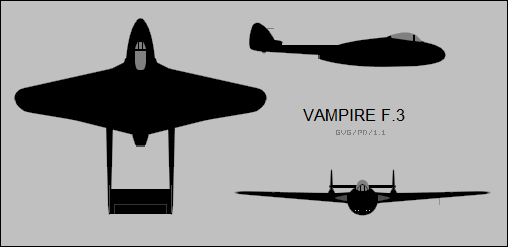
The first "Vampire F.3" -- not "F.III" this time around -- flew on 4 November 1946. It featured the Goblin 2 engine, more power being needed since maximum take-off weight had increased by 50%. Range and endurance were as much as doubled. Deliveries of production aircraft began in the spring of 1947, with a total of 224 built from 1947 to 1949. The bulk of them, 118, went to the RAF. The Royal Navy also obtained six; Canada obtained 86, Norway 10, India 3, and Sweden 1.
Two Vampires were shipped to Singapore in early 1948 for test and trials under tropical conditions, with one used for static tests and the other for flight tests. The flight test aircraft then performed a tour of Far Eastern countries afterward, and flew to Khartoum in the Sudan for further trials in mid-March. It was back in the UK by the end of the year.
On hearing that the Americans were planning a jet crossing of the Atlantic, the British decided to trump them. In July 1948, six RAF Vampire F.3s under Squadron Leader R.W. Oxspring became the first jet aircraft to cross the Atlantic, performing hops through Iceland, Greenland, Labrador, and Newfoundland to end up in the US. The exercise demonstrated that jet aircraft were suitable for long-range operations. The Vampires then toured the US and Canada. One US Air Force (USAF) F-80 pilot took a flight in a Vampire and was suitably impressed. By that time, the F.3 was in squadron service in Europe and elsewhere.
* Although the Vampire had originally been ordered for the air combat / interceptor role, the RAF decided to standardize on the Gloster Meteor for that function. That left the issue of what to do with the Vampire; the logical thing was to adapt it to the ground attack role, replacing the Hawker Tempest.
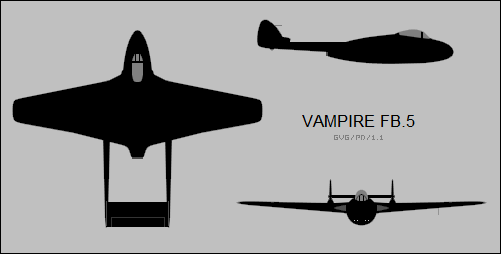
The effort to build a ground-attack Vampire went through a set of ups and downs, but the first prototype of the "Vampire Fighter-Bomber Mark 5 (FB.5)", modified from a Vampire F.3, performed its initial flight on 23 June 1948. The FB.5 retained the Goblin 2 engine of the F.3, but featured armor protection around engine systems, wings clipped back by 30 centimeters (1 foot), and longer stroke main gear to provide clearance for stores and handle greater take-off weights. Although an ejection seat was considered, it was not fitted.
___________________________________________________________________
DE HAVILLAND VAMPIRE FB.5:
___________________________________________________________________
wingspan:
11.6 meters (38 feet)
wing area:
24.34 sq_meters (262 sq_feet)
length:
9.37 meters (30 feet 9 inches)
height:
2.69 meters (8 feet 10 inches)
empty weight:
3,290 kilograms (7,250 pounds)
MTO weight:
5,620 kilograms (12,390 pounds)
maximum speed:
915 KPH (570 MPH / 495 KT)
service ceiling:
12,200 meters (44,000 feet)
range:
1,930 kilometers (1,200 MI / 1,045 NMI)
___________________________________________________________________
A typical warload was an external tank or 225-kilogram (500-pound) bomb outboard on each wing, and eight 7.62-centimeter (3-inch) rocket projectiles ("RPs") stacked in pairs on four attachments inboard of the booms.
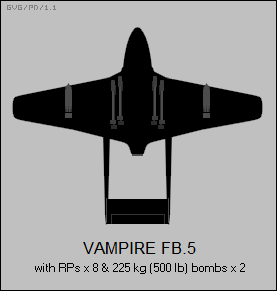
Service deliveries of the FB.5 to the RAF began in late 1948. The type left a bit to be desired, suffering from various teething problems early on. They were resolved, but effective use of the main offensive weapon, the RP, was always something of an art, and the lack of an ejection seat was unsurprisingly a source of dismay for pilots. However, the FB.5 was the definitive single-seat Vampire, with 1,123 built from 1948 to 1951, including 10 for South Africa and 24 for Venezuela. Most FB.5 production was performed by English Electric.
At its peak, 19 RAF squadrons flew the FB.5 in Europe, the Middle East, and the Far East. The FB.5 performed strikes during the successful British campaign to suppress the insurgency in Malaya in the late 1940s and early 1950s. The RAF relegated the Vampire to advanced training roles in the mid-1950s, and the type was generally out of RAF service by the end of the decade.
* After the purchase of the four F.1s for evaluation, the Swiss purchased the FB.5 with an uprated Goblin 3 engine, providing 14.9 kN (1,520 kgp / 3,350 lbf) thrust, with this variant designated "Vampire FB.6". Switzerland obtained 75 from British production, and license-built 100 more at Emmen. 55 of these machines were fitted with an extended nose for additional avionics in the 1970s. Incidentally, there was never an "FB.7", except as a concept that came to nothing; details are unclear.
The Swedes bought 310 FB.6-type machines with the company designation of "Vampire FB.50" and the local designation of "J 28B". After receiving a number of ex-RAF F.1s and FB.5s, the French AA obtained a set of license-built FB.5s, known as "FB.51s", from Sud-Est. Sud-Est built 67 FB.51s using British-supplied components, with the first flying on 27 January 1950. They were followed by 120 machines built completely in France, powered by Hispano-built Goblin engines, the first of the set flying on 21 December 1950. Some sources claim the French-built FB.51s were powered by Nenes, but this appears to be a confusion with the Mistral, discussed above.
Another variation on the FB.6, the "Vampire FB.52", was exported to a number of countries, with 193 built from 1949 to 1953 for ten different nations, and 247 license-built in India. The Italians obtained a slightly modified "FB.52A", with 51 exported from the UK and 195 built by Fiat and Macchi in Italy.
* The FB.5 was to be followed by a considerably revised "Vampire FB.8" variant with a new Ghost turbojet -- an improved Goblin, discussed later -- and new "thin" wing, with two FB.5s converted to this configuration as prototypes in 1949. The scheme proved successful, but the changes were so drastic that the decision was made to give the aircraft the new name of "Venom", discussed later, and so the next single-seat Vampire was the "Vampire FB.9".
The FB.9 was basically a "tropicalized" FB.5. The FB.5's cockpit proved to be an unbearable "hot box" in tropical climates, and so the FB.9 was fitted with a Godfrey air-conditioning unit in the right wing root. The FB.9 looked much like an FB.5, the biggest giveaway being a modified right engine inlet to feed the air-conditioning unit, with an extended boundary-layer plate in front of the inlet.
Vampire FB.9s replaced FB.5s in the Middle East and Asia beginning in 1952, and they were used to fight nationalist Mau-Mau insurgents in Kenya. The FB.9 was the last single-seat Vampire built, with a total of 348 manufactured from 1951 to 1953. 332 of these machines went to the RAF, with the other 16 going to Rhodesia. The Rhodesian machines differed by being fitted with the Goblin 3 instead of Goblin 2 engine, permitting better performance under "hot-&-high" conditions.
BACK_TO_TOP* The British Royal Navy's Fleet Air Arm (FAA) was interested in the Vampire from early on. The second Vampire prototype, fitted with larger flaps and air brakes, was flown beginning in May 1945 for a preliminary assessment of its suitability for carrier operations; this going well, the prototype was modified with a yoke-style arresting hook, which retracted through the exhaust flow into a fairing above the exhaust, as well as a teardrop canopy and a Goblin 2 engine, in preparation for actual carrier operations. On 3 December 1945, the "Sea Vampire" performed the very first jet carrier landings and take-offs, with Lieutenant Commander Eric Brown performing several landings and take-offs on the HMS OCEAN off the Isle of Wight.
Although the trials went well, the FAA finally decided that the Sea Vampire wasn't what the service required for a first-line fighter, but it did seem like a cost-effective training and evaluation machine for bringing the Royal Navy up to speed in jet carrier operations -- and so, in early 1947, a batch of "Sea Vampire F.20" machines was ordered for that purpose.
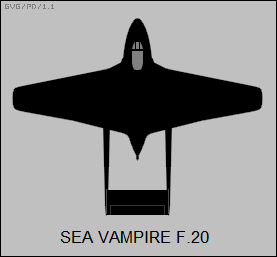
The F.20 featured the larger flaps, larger airbrakes, and the arresting hook featured on the Sea Vampire demonstrator; it also added ruggedized, long-stroke landing gear, plus FB.5 clipped wings. Although 30 F.20s were ordered, only 18 were actually obtained, all as modifications of Vampire F.3s or F.5s. Initial service deliveries were in October 1948. Pilots found the F.20 to be very pleasant on carrier approach, particularly with the fine view from the set-forward cockpit, but unpleasantly sluggish on take-offs when catapult wasn't used. The Sea Vampire F.20s were finally pulled from service in 1956 and 1957, to be scrapped in 1960.
* One of the odd footnotes of the Vampire's service with the Royal Navy in which the type performed "wheels up" arrested landings on carriers. The idea was that eliminating the heavy landing gear would improve fighter performance; the fighter would "belly in" on a "flexible deck" or "mattress" composed of heavy layers of rubber on top of a matrix of fire hoses. A Vampire F.1 was modified to test this idea, performing an initial wheels-up landing test on 29 December 1947, setting down on a mattress set up on an airfield, with Eric Brown doing the honors. It didn't go well, with the landing proving so rough that the aircraft had to be written off. Brown was unhurt.
The Royal Navy was undiscouraged. Two "Sea Vampire F.21" machines were built in 1948, both being similar to the Sea Vampire F.20 but with a reinforced belly and other tweaky changes; landing gear was retained. Landings were performed on a mattress set up on the carrier HMS WARRIOR in 1948 and 1949. Things went much better, and it seemed the flexible deck system could be made to work -- but though the Royal Navy tinkered with the notion into the early 1950s, overall it was just too much of a nuisance.
BACK_TO_TOP* De Havilland also developed a two-seat version of the Vampire using company funds, designated the "DH.113". The DH.113 had the wings and tail of the single-seat Vampire FB.5 with a new fuselage, stretched by 1.17 meters (46 inches) to accommodate AI.X (US SCR-720B) radar and featuring a cockpit with side-by-side seating, the pilot in the left seat and the navigator / radar operator in the right. The two seats were a tight fit, and so they were staggered, with the pilot's seat forward of the navigator / radar operator's seat. The crew sat under a single canopy that hinged up in the rear; ejection seats were not fitted, but the canopy could be jettisoned in an emergency.
Since the DH.113's weight was 122 kilograms (270 pounds) greater than that of a single-seat vampire, the uprated Goblin 3 engine was fitted. The DH.113 retained the quad Hispano Mark V 20-millimeter cannon of the single-seaters, and could carry a fuel tank under each wing. It could also carry a bomb under each wing as an alternative external store.
Three prototypes were built, the first performing its initial flight on 28 August 1949 with test pilot Geoffrey Pike at the controls; it was appropriately named "Pike's Pig", and flew at the Farnborough air show nine days later. Test flights showed the DH.113 was actually slightly faster than an FB.5, due to the Goblin 3 engine and improved aerodynamics. It was, however, slower than a Meteor night-fighter and had a substantially poorer rate of climb.
* The month after de Havilland showed the DH.113 off at Farnborough, Egypt ordered 12 of the machines, but tensions were very high in the Middle East and the British government embargoed weapons shipments to the region. The Egyptians never saw these machines; the RAF took over the order, designating the type the "Vampire Night Fighter Mark 10 (NF.10)", using it as an interim solution until late-mark Meteor and Venom night fighters were available.
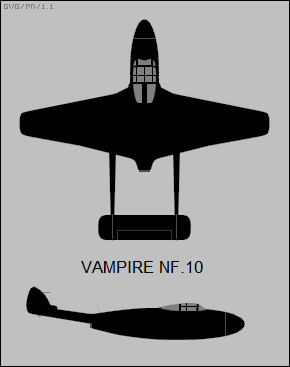
Initial service deliveries of the NF.10 were in the spring of 1951. Their Egyptian origins were well-known among RAF pilots and NF.10 aircrew were kidded a bit about it, for example by asking them if they could read the instrument panel indicators. The NF.10 was a good aircraft and generally well-liked -- though crews were never happy about the lack of ejection seats. Still, it was indeed an interim solution; it could catch piston bombers like the Avro Lincoln and the Boeing B-29 easily enough, but it was hard-pressed to hunt down an English Electric Canberra. Only 78 NF.10s were built, and they only remained in firstline service to 1954.
* After their retirement from the night-fighter role, 36 NF.10s were converted to a navigation trainer and redesignated "Vampire NF(T).10". The AI.X radar was yanked, being replaced by ballast in the form of concrete blocks, and the navigation kit was upgraded. The NF(T).10s remained in service until 1959.
De Havilland also built an export variant of the NF.10 designated the "Vampire NF.54". A total of 14 was built for Italy and delivered in 1952:1953; 30 retired NF.10s were also refurbished to the NF.54 configuration for India, with deliveries from 1954 to 1958.
* The Vampire having proven popular, in the spring of 1950 de Havilland brass decided to develop a two-seat side-by-side trainer variant, the "DH.115". Initial flight of the prototype was on 15 November 1950, with John Wilson at the controls. The RAF was intrigued by the DH.115, seeing it as a useful complement to the Meteor T.7 trainer, and performed a lengthy evaluation of the prototype from the spring of 1951 to early 1952. Production orders followed, with the "Vampire T.11", as the RAF designated it, going into service in the fall of 1952. The RAF obtained a total of 526.
The T.11 was generally based on the NF.10 and looked much like it, though the cockpit had been redesigned for more space, and the seats were not staggered. The NF.10 had a pull-off nose to give access to the radar; the T.11 had a neat hinge-up "hood" or "bonnet" for servicing systems in the nose. The T.11 was powered by the Goblin 33 engine, which was essentially a Goblin 3 modified to provide air bleed from the engine compressor for cabin pressurization; the Goblin 3 had used an external blower for that purpose. The T.11 was in principle combat-capable, retaining the four-cannon armament -- though usually only two were fitted -- as well as the capability to carry external stores.
Aircrews found the performance and handling of the T.11 satisfactory, but the NF.10-style canopy provided a poor field of view, the cockpit was cramped, and there were still no ejection seats. The 144th T.11 introduced a "blown" canopy with a much better field of view, plus a new tailfin that featured a long dorsal extension, and twin Martin-Baker Mark 3B ejection seats. Earlier production was brought up to the same standard.
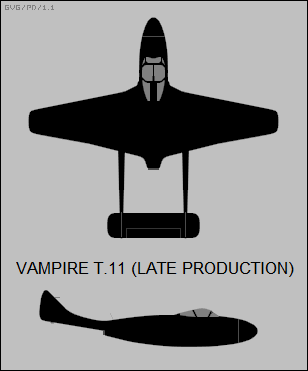
The T.11 flew with RAF Training Command until 1962, when it was replaced by the Folland Gnat T.1. A few T.11s remained in RAF service in miscellaneous roles until 1967.
* The Royal Navy also acquired 73 T.11s with minor modifications under the designation "Sea Vampire T.22", with deliveries from 1952 to 1955. Despite the name, they were not carrier-capable. As with the T.11s, early production had the original framed canopy and lacked ejection seats; the blown canopy and ejection seats were added in later production and retrofitted to earlier machines. The Sea Vampire T.22s served into the early 1960s, with some then phased out, some passed on to other air arms, and a few lingering as hacks up to about 1970.
An export version, the "T.55", was produced as well, with a total of 232 built in the UK for foreign customers. The Swiss built 30 T.55s under license, while India built 60; some of the Indian T.55s were converted to a photo-reconnaissance configuration and redesignated "PR.55". CAC in Australia built a series of their own trainer variants, including:
All the Aussie trainers had the uprated Goblin 35 engine, which provided 15.6 kN (1,590 kgp / 3,500 lbf) thrust.
* After the service life of the Vampire, in the late 1960s an American firm, Jet Craft of Las Vegas, Nevada, came up with schemes for modernizing surplus T.11s, the most intriguing being a six-seat business jet configuration named the "Mystery Jet II", with a new forward fuselage and a Rolls-Royce Viper turbojet replacing the Goblin. It was something of a fun idea, but Jet Craft then went broke, with the company's boss ending up doing a year in jail on criminal contempt charges, and the Mystery Jet II never flew. Apparently Jet Craft was resurrected for a time in the late 1980s and proposed concepts much along the same lines as before, but by that time the whole idea was a complete nonstarter.
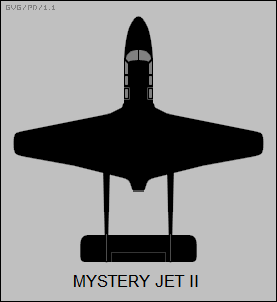
* A total of over 4,580 Vampires of all types was built, with the last of them leaving (Swiss) military service in 1990. The type still survives in private hands as a warbird airshow attraction. While the Vampire saw little real combat action, it was a valuable tool for giving the RAF and other services a bridge between the piston and jet fighter ages.
BACK_TO_TOP* One of the interesting incidental stories in the history of the Vampire was the de Havilland "DH.108" experimental aircraft. During the later part of World War II, de Havilland engineers considered a number of possible configurations for a jet airliner, including one that looked like a scaled-up Vampire. After the end of the war, the studies focused on a tail-less airliner with four de Havilland Ghost turbojets that was given the company designation of "DH.108".
The tail-less scheme was something new and uncertain, so in early 1946 the Air Ministry authorized construction of two experimental demonstrators under "Specification E.18/45". The aircraft were to be essentially Vampire F.1s with a swept wing and no tail; they were assigned the company designation of "DH.108", and were informally given the name of "Swallow".
Fuselages of two F.1s under construction were pulled from the English Electric production line for the project. The first prototype -- powered by a Goblin 2 turbojet and featuring a wing with a fixed leading-edge slat and a sweep of 40 degrees -- performed its initial flight on 15 May 1946, with Geoffrey de Havilland JR at the controls. It was a pretty machine, looking much like a Vampire crossed with a Messerschmitt Me 163 Komet, and despite its unusual configuration, de Havilland reported it handled well.
The second Swallow performed its initial flight on 23 August 1946. It featured a Goblin 3 engine and a wing with automatic leading-edge slats, powered flight surfaces, and a sweepback of 45 degrees. Although further engineering work had shown the tail-less configuration to be inefficient for an airliner, the second Swallow prototype proved capable of 1,050 KPH (650 MPH), very impressive performance at the time. The flight tests were continued in the name of high-speed research.
In fact, there was a belief that the DH.108 could break the world speed record, and flights were performed that were to lead up to a formal record attempt. This exercise ended in tragedy: on 27 September 1946, Geoffrey de Havilland was flying the second prototype, when it shed its wings over the Thames estuary. De Havilland was killed. The accident investigation showed the aircraft had been structurally overloaded at a speed of about Mach 0.9.
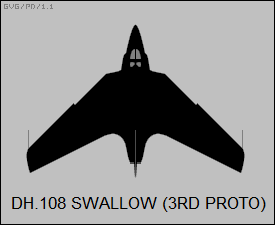
The attitude was that the problems could be overcome, and so in July 1947 a contract was issued for a replacement DH.108. This third Swallow, based on an F.5 fuselage, performed its first flight on 24 July 1947, with John Cunningham at the controls. It featured a longer nose and a more streamlined canopy. It was the first British aircraft to exceed Mach 1, apparently in a dive, with John Derry accomplishing the feat on 6 September 1948.
Both the first and the third DH.108s remained in flight trials for several more years. The tragedies were not over: the pilot of the third prototype, Squadron Leader Stuart Miller-Rowland, apparently suffered a failure of the oxygen system on 15 February 1950 and flew into the ground; then, on 15 May 1950, the first prototype, flown by Squadron Leader George Genders, went into an unrecoverable and fatal spin. The DH.108 trials were apparently successful in the technical sense, but the Swallow turned out to be a murderously unlucky aircraft.
BACK_TO_TOP